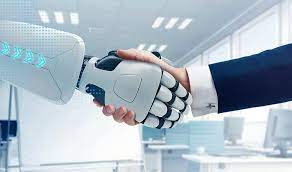The Role of AI in Human Resource Management
- October 3, 2023
- Posted by: Mohammed Abiola
- Category: Uncategorized

No doubt, artificial intelligence has come to stay, and it is pertinent for every sector of the economy to embrace it as the new world order. We know that many people have reservations concerning this, as the fear of being replaced by machines outweighs the benefits it offers in terms of making our lives run smoothly with minimal stress. Machines have become a part of our lives since the advent of the Industrial Revolution, and all we have been doing since then is improving on them to meet our ever-changing needs.
As many sectors or departments in an economy or company are beginning to embrace this, human resource management is not left out of the mix, as artificial intelligence tools have been created to make the work of human resource professionals more efficient and effective. However, every invention of man has its pros and cons, but as long as its benefits outweigh its problems, one can safely say that such an invention would be beneficial to humanity.
Pros of AI in human resources
Let’s take a look at some of the benefits of artificial intelligence to human resource management in the wake of its usage:
- It offers a more efficient recruitment process i.e., it helps to screen resumes faster by bouncing off resumes that do not meet the job description and person specification of a job advert. Also, it analyses social media profiles to identify potential candidates which is a form of passive candidate sourcing.
- It reduces diversity and inclusion biases during the selection/screening process as it takes demographic and psychographic data into consideration.
- It improves employees’ onboarding process, making it fast and seamless, and helps to retain top talent in the organization.
- It helps to promptly resolve customers’ queries and improve their engagement with the organization both online and offline.
- It fosters personalized learning and development (L&D) for employees where they are trained on their specific needs to help them get better at their jobs.
- It is used to analyze employee data by identifying their strength and playing to it.
- It drives employee engagement and satisfaction as there are chatbots or virtual assistants readily available to provide 24-hour support for them in terms of inquiries regarding benefits, policies, onboarding, and general human resource information.
Cons of AI in human resources
As there are two sides to a story, there are downsides to the use of artificial intelligence in human resource practice, and they include:
- The danger of privacy breaches and rights violations
- There is a lack of human touch to decipher which candidate would appreciate and promote the company’s culture and values during the recruitment process and which one would not.
- System errors might come up from time to time, which could lead to misinterpretation of data or jeopardize the selection and screening process of job candidates.
- Pattern-driven issues, i.e., the ‘patterns’ have been set into the system without giving room for flexibility to make exemptions.
- There is personal bias in how artificial intelligence is programmed to work, as it follows the concept of garbage in and garbage out. This means that the outcome may not necessarily reflect the true state of things, just the bias of the programmer(s).
Ways AI can simplify human resources management
So, having discussed its benefits and problems, it is safe to say that we can proceed to how artificial intelligence has made human resource management more manageable for human resource professionals, and they include the following areas of human resource management:
Recruitment
It scans resumes, making it easier to find suitable job candidates as its automated screening process gives prospective job candidates a fair chance of selection during the evaluation process. Finally, it reduces the workload on human resource professionals because it helps them do most of the work.
Onboarding
it tailors the onboarding process to suit each employee’s needs so they can get suitable training and information. Also, it helps to analyze surveys and feedback so that human resource personnel can tackle administrative issues head-on. Lastly, it helps with predictive analysis, where the risk of losing top talents is identified, and preventive measures are put in place to combat this.
Payroll
It makes the payment of employees’ salaries and benefits easy as it is automated, just as it helps to check the number of times employees show up for work against the number of times they are expected to. The use of artificial intelligence in payroll helps to reduce incessant errors that come up in payroll management as a result of it being done manually.
Performance management
It analyzes performance data to understand trends, patterns, and areas that need improvement. This actually goes both ways, i.e., on the employees’ side and on the employer’s side. It assesses the employees to know if they are the right fit for the company and assesses the organization to know if they are meeting their client’s needs.
Learning and development
It recommends training and development opportunities for employees based on their skills, career goals, and competence. These recommendations are used to tailor developmental training for each employee to enhance their performance at work.
Employee retention
It can detect high achievers in the organization and identify ways to keep them by constantly exposing them to leadership training and opportunities and rewarding their commitment to the organization.
In conclusion, PoweredUp Consulting has been able to successfully infuse artificial intelligence into human resource management in areas of recruitment, onboarding, payroll, training and development, performance management, employer of records, employee retention, and other administrative tasks. So, what are you waiting for? Kindly contact us
